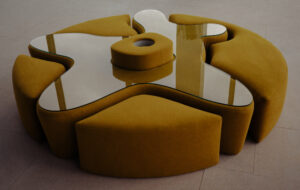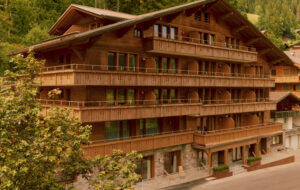
words Anna Bates
The rendered image has seduced photography. There was a time when the computer-generated image wanted to be like a photo. Now, it’s the other way round. The weird perfection of renderings has influenced designers to the point that when they publish their work, they no longer want it to look real.
This new breed of image is initially taken with a camera, yet the objects portrayed live in a neutral space, sometimes with no floor or background, and always without a trace of imperfection. In fact, these objects look so flawless that we can’t tell whether they are real or not: with the help of controlled lighting and Photoshop, they’ve been manipulated to look more perfect than real, to look like renderings. These images appear on blogs, magazines and advertisements, and puzzle the viewer as to whether the object actually exists.
“Generic”, “clean”, “pure” – these are the terms many designers are using to describe the images they want of their products. London-based designer Assa Ashuach says treating photographs in this way is about “giving only the essential information – getting the purest form of the image.” For Moooi founder Marcel Wanders, it is about creating a sense of “magic”, while Swedish quartet Front says designers don’t want to take the risk of producing natural-looking photos for the media: “There is the worry that it wouldn’t look stylish enough next to the other objects,” says Sofia Lagerkvist.
“We’ve become so used to seeing images in a rendered way,” says Ashuach. “It’s almost like we started to use renderings, and now photography is following the rendering.”
This kind of image treatment is especially prevalent in automotive promotional material. For the current Citroën C5 campaign, for example, the cars were photographed to capture a “mood” – something that is still difficult to achieve with computer renderings. But the images are then worked on in Photoshop to enhance them. “We work on reflections, blemishes, details, such as the alloy of the wheel, that the human eye can’t quite see,” says Citroën account director Will Pollen from advertising agency Euro RSCG. “You want to communicate the detail that is really there.”
But it isn’t just about presenting information: “You’re trying to create an air of total desirability,” says Pollen. “Natural might be real – but if you need to shift products, no one cares about that. You don’t have the luxury of being able to stay in the world of the real, you have to stay in the world of pure beauty and desirability.” Similarly, computer and mobile brands such as Apple will present images of products that belong in a world outside of reality: “You always see Apple products in front of this perfect white ‘non-space’ – because the real world is not perfect enough for the perfect Apple product,” says Munich-based industrial designer Konstantin Grcic.
It is this “hyperreal” aesthetic that Wanders enjoys portraying in images of Moooi’s products – all of which are either heavily Photoshopped, or rendered. “Photoshop is a way to manipulate the world into what you want it to be. If you want to make your piece of furniture a miracle piece you have to take it out of the context you would normally see it in and put it in a virtual world.” For Wanders, this means taking a sharp, close-up photograph of the object, playing with the contrasts, cutting out the images and inserting fake shadows.
British design duo Barber Osgerby says that when the first image of the product is a render, it’s inevitable that the photo of the final object will resemble it. “When it comes to doing the photo-shoot, a rendering is like a storyboard for the film. You already have an idea of the image you want to achieve.”
Grcic takes this even further. He says that the rendered image can actually interfere with the design process. “These images are so strong,” says Grcic. “They get stuck in the manufacturer’s heads. We’ll often want to change something, and they’ll always come back to that same image to say ‘but it looked so beautiful then’. The whole process becomes reversed. Normally, we work to create the object and then take a photo of it. Now we almost create the photograph and then work backwards.”
Renders have created a new image economy perpetuated by blogs and magazines, in which the currency is one of hyper-perfection. Many of the designers that icon spoke to found they were subconsciously enhancing their images, if only because they were concerned their products would look unpolished compared to other images in the media. “What you see on some blogs now is just crazy,” says Grcic. “Whenever you see a real product it looks really sad against all the hyper stuff.”
Most people will only see the finished products on blogs or in magazines, and it’s almost as though the image is more important than the real object. Both renderings and retouched photographs enter a “media space” in which unrealistic standards of perfection prevail. The uncanny similarity of the images creates a middle ground where you can’t tell what is real and what isn’t.
In part, the aesthetic of this middle ground is becoming more widespread because the software used to create it, such as Hypershot, has become readily available. In many ways, it has given designers a certain amount of control. “When you develop your skills in a 3D environment, you can also be the one behind the camera,” says Ashuach.
The tendency towards digital photography also makes working on the images much easier. “It’s just digital information that you can manipulate easily,” Grcic says. Photographer Tom Vack describes digital photography as a “renaissance”. “It’s become much more about illustration and rendering than it is about capturing a moment in time. I spend more time in Photoshop than I spend taking a picture.”
The possibilities of the digital image are especially seductive to younger creatives – but lack of experience means Photoshop can tempt them into rushing through the process of shooting a picture. “Some don’t think they need to look at the object because they’re going to look at it in Photoshop and deal with it later,” says Vack. “But the more you have to do, the more unreal it gets – and then you have to be fantastical because you have no choice but to make the object look like it ‘could’ have happened.”
In spite of rendering software having become so advanced, there are a lot of lower quality renderings around that reflect a lack of skill and inexperience: “A lot of creatives don’t have the understanding that visual effects technicians have – you get this effect that isn’t photorealistic,” says Zissou, a London-based artist who works with Hypershot.
Ultimately, what appears so desirable now may soon seem out of date. Vack thinks that this hyperreal vision of the product will exhaust itself. “People have a way of getting tired of beauty – they become saturated with it. I wouldn’t be at all surprised if there is a strong back-to-nature, natural movement in commercial photography – if nothing else, just to buck the trend and make yourself stand out again.”
Grcic also thinks the aesthetic will destroy itself: “People will stop believing in these images – they will be sobered up by their disappointment when they see the real thing.”
top image Retouched photograph of Geoffrey Lilge’s L40 armchair, 2008

Retouched photograph of Mattia Bonetti’s Heather chest of drawers, 2008

The Citroën C5, 2008














